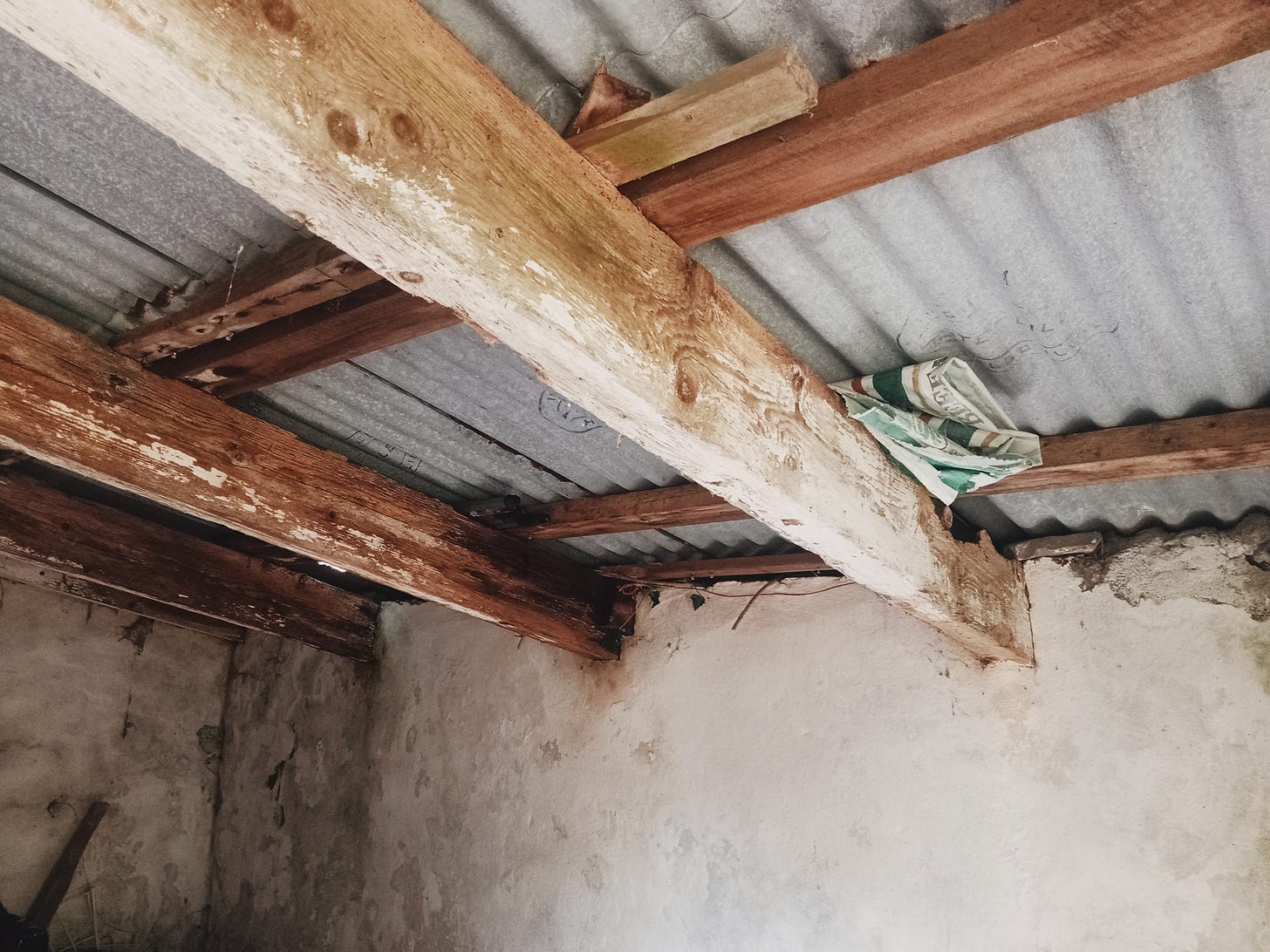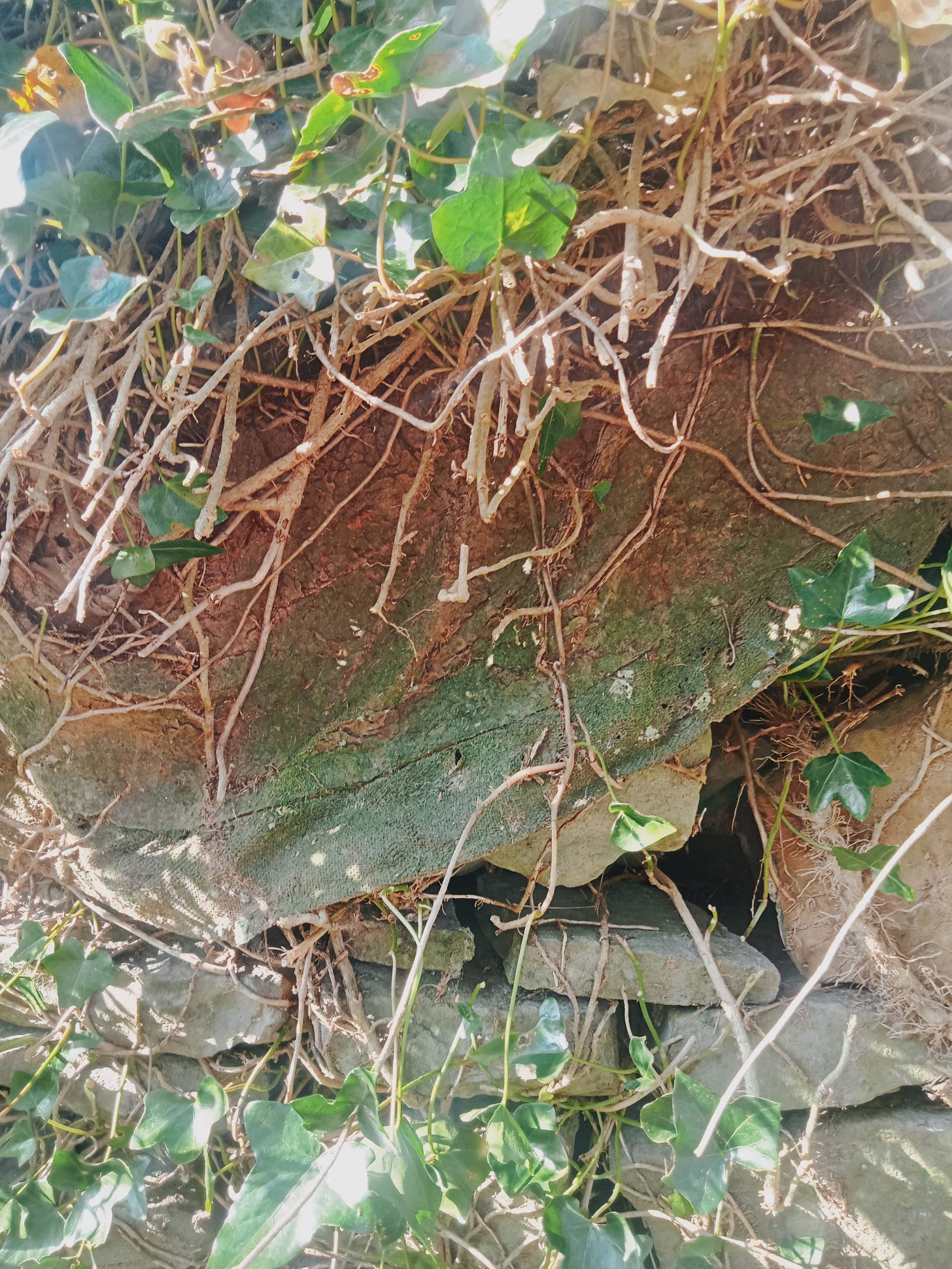There’s an old tin-roof shed down the garden, next to the farmyard. It was the piggery. And what a perfect pig house it was. Now ivy-clad and overgrown, it’s still perfectly pig peaceful. It’s been catching the morning sunrise, lighting up a corner of the cottage garden in rays of glowing red, this past week of good weather.
I use that term ‘cottage garden’ loosely. In reality, it’s more nettles and briars than phlox and daisies.
Still though, I love it anyway.
It’s just so aesthetically beautiful, all lichen, stones and ivy. There are shoots of Saint John’s Wort (named for Saint John the Baptist, because it’s in bloom for his feast day), nettles and whitethorn, springing up between the Liscannor flags of the tiny courtyard.
These pigs were royalty you see, they could wander out from the cool shade of the old shed into the courtyard at any hour of the day, and bask in the sunshine.
The little piggery itself faces east, the entrance door faces south. The pigs yard is enclosed by stone walls on three sides; east, south and west. Inside, the original timber rafters, which would have held in place a roof of Liscannor flagstones, are still intact. At some point the flag roof was replaced with round profile metal sheeting, coated in red oxide paint, manufactured at the Irish Steel plant on Haubowline Island, in Cork Harbour. This was Ireland’s only steelworks and it operated from 1939 until 2001, when it closed with the loss of 400 jobs. The plant dumped slag waste from the steel manufacturing process into Cork Harbour from the 1960’s which cost the State many millions to clean up afterwards. How many stories I wrote about that while reporting down in Cork. And here in the roof of the piggery is the Irish Steel stamp, just a few inches above my head.
The pampered pigs that lived in here endured no bare stone walls. Their homestead was lime plastered and limewashed, which had a duel effect of brightening the interior and killing off bacteria.
They even had a little aluminium window facing south, for winter days I suppose, when they preferred to cuddle up in their body heat, indoors. The glass is gone now, but the mechanism still works and I picture a farmer or perhaps a farmer’s wife, opening it for to let in some fresh crisp air to the pigs. Not too much that it would cause a draft, mind.
Many times I thought, when the farmhouse itself seemed an impossible task, that I could perhaps leave it alone for a while and conduct a few adjustments to the piggery instead. A bit of insulation for the red tin roof, a pane of glass for the window, a little stove to stay cosy, in the absence of a pig to share a bed with.
The door looks a little defeated however, despite some ambitious patching efforts.
My sister used the piggery as an art studio during lockdown. The neighbours thought I was being mean, sending her off down the field to the pig house. In fact she spent many contented hours down there, with a soundscape of singing birds for company.
For the purposes of pig research, I looked up on the internet things that pigs don’t like. Here's the bullet point list as it appears on the page:
Loud noise and yelling
Moving too fast
Moving in groups that are too large
Overcrowding
Stationary periods that are too long
Amen I say, to all of that.
I’ve taken to bringing a cup of tea down to the piggery in the mornings.
To soak in the Pig Vibes.
A slow-paced, sheltered, sun trap. The chief attraction in the absence of pig, is proximity to the cattle, who live over the wall in the cow sheds, so I can hear them shuffling around, chewing hay, mooing among themselves. The cows eyeball me in their watchful gaze, not hugely interested. They don’t answer me when I bid them Good Morning except to turn and look and sometimes bat their bovine lashes in my direction.
I have neglected the piggery this past year, so that only patches of the tin roof are visible now, underneath an overcoat of ivy. There’s another overcoat here. An actual overcoat that I found thrown over the wall not long after I first arrived. There was some hilarity when I told the family that lived here before me about it. The previous owner, (apparently in his day, one of the finest stonemasons in North Clare) had wondered for years where his good coat had gone to.
I never moved the overcoat. It didn’t seem right.
Last week, in the glorious sunshine, I cut away a strip of ivy to do a condition check. It’s still there, in pretty much the same condition. I called out to the neighbour, who was in feeding the cows.
“The old coat! It’s still here!”
“What?” came the gruff reply.
“The missing overcoat is still here!” I called back, happily. He stood looking at me for a moment, until he understood. Then let out a reluctant chuckle.
Should I move the coat inside I wonder? I’m not sure what I’ll do if I go looking some day and find it’s fraying edges disappeared altogether.
The coat is kind of like my comfort blanket. When the world outside seems to be going quite mad, the coat and the bees and the birds and the breeze are my favoured company. I can hear the relaxed out-breath of the former resident pig turning himself in the sun. I can feel the coat-owner exhale a contented sigh, taking the cigarettes out of the pocket before laying it carefully across the wall.
To rest awhile, in the evening sun.
Option to ‘buy a coffee’ here












What a delightful and well-written article! That piggery looks terrific. I think a person could live there quite happily.
When I saw the headline I thought it must be some kind of verbal attack on the men and women in blue. But when I noticed the author's name I realised it must be about actual pigs, and so it transpired! DG.
Oh Louise, I love this! I felt like I was back at the cottage with you!